Tokyo
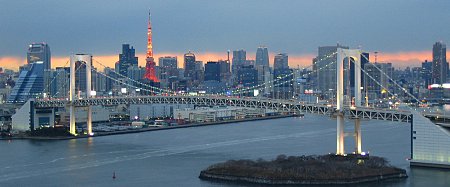
Tokyo is Japan's capital and the country's largest city.
Tokyo is also one of Japan's 47 prefectures, but is called a metropolis (to) rather than a prefecture (ken). The metropolis of Tokyo consists of 23 city wards (ku), 26 cities, 5 towns and 8 villages, including the Izu and Ogasawara Islands, several small Pacific Islands in the south of Japan's main island Honshu.
The 23 city wards (ku) are the center of Tokyo and make up about one third of the metropolis' area, while housing roughly eight of Tokyo's approximately twelve million residents.
Prior to 1868, Tokyo was known as Edo. A small castle town in the 16th century, Edo became Japan's political center in 1603 when Tokugawa Ieyasu established his feudal government there. A few decades later, Edo had grown into one of the world's most populous cities.
With the Meiji Restoration of 1868, the emperor and capital were moved from Kyoto to Edo, which was renamed Tokyo ("Eastern Capital"). Large parts of Tokyo were destroyed in the Great Kanto Earthquake of 1923 and in the air raids of 1945.
Sensoji
Sensoji (also known as Asakusa Kannon Temple) is a Buddhist temple located in Asakusa, the center of the shitamachi (lit. "low town").
The legend says that in the year 628, two brothers fished a statue of Kannon, the goddess of mercy, out of the Sumida River, and even though they put the statue back into the river, it always returned to them. Consequently, Sensoji was built there for the goddess of Kannon. The temple was completed in 645, making it Tokyo's oldest temple.
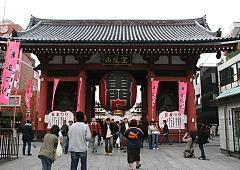 | 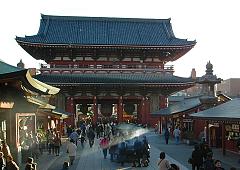 |
When approaching the temple, visitors first enter through the Kaminarimon (Thunder Gate), the outer gate of the Sensoji and symbol of Asakusa. A shopping street of over 200 meters, called Nakamise, leads from the outer gate to the temple's second gate, the Hozomon. Besides typical Japanese souvenirs such as yukata and folding fans, various traditional local snacks from the Asakusa area are sold along the Nakamise. The shopping street has a history of several centuries.
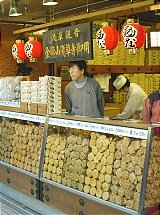 | 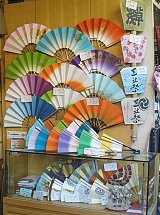 | 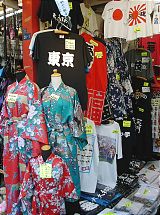 |
 | 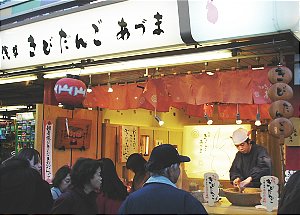 |
| from left to right: Kibidango - Skewered kibi-balls covered with soybean powder; top: Agemanju - deep fried manju (soft cake with red bean paste filling); bottom: Ningyoyaki - small cake with red bean paste filling; Kibidango Shop | |
Beyond the Hozomon main gate stands the temple's main building and a five storied pagoda. The Asakusa Shrine, built in the year 1649 by Tokugawa Iemitsu can be found close by the temple's main building.
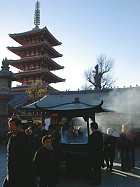 | 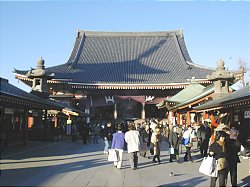 |
Sensoji Temple is a few steps from Asakusa Station, served by the Ginza Subway Line, Asakusa Subway Line and Tobu Railways.
From Tokyo Station Take the JR Yamanote Line to Kanda Station (2 minutes, 130 Yen) and transfer to the Ginza Subway Line for Asakusa (10 minutes, 160 Yen).
From Shinjuku Station Take the orange JR Chuo Line to Kanda Station (10 minutes, 160 Yen) and transfer to the Ginza Subway Line for Asakusa (10 minutes, 160 Yen).
Meiji Shrine
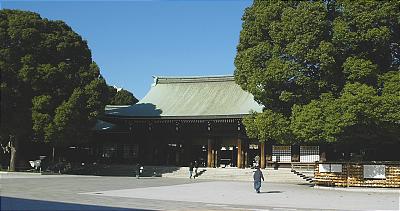
Meiji Shrine (Meiji Jingu) is a shrine dedicated to the deified spirits of Emperor Meiji and his consort, Empress Shoken. In Shinto, it is not uncommon to enshrine the deified spirits of important personalities.
Emperor Meiji was the first emperor of modern Japan. He was born in 1852 and ascended to the throne in 1868 at the peak of the Meiji Restauration when the power was switched from the feudal Tokugawa government to the emperor. During the Meiji Period, Japan modernized and westernized herself to join the world's major powers by the time Emperor Meiji passed away in 1912.
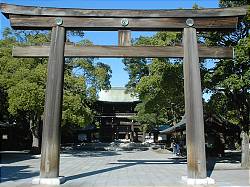 | 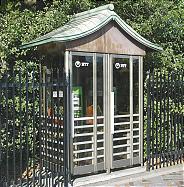 |
The Meiji Shrine was completed in 1920, and rebuilt after being destroyed in World War Two. It is located in a wooded park area next to Yoyogi Park in Tokyo. Various events and festivals are celebrated at the shrine throughout the year.
The approach to Meiji Shrine starts a few steps from Harajuku Station on the JR Yamanote Line or Meiji-jingu-mae Station on the Subway Chiyoda Line.
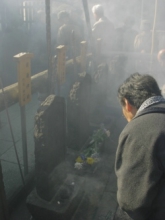
Sengakuji
Sengakuji is a small temple in Minato-ku, Tokyo, famous for its graveyard where the "47 Ronin" (also known as Akoroshi, the "masterless samurai from Ako") are buried.
The story of the 47 loyal ronin (see below) remains one of the most popular historical stories in Japan, and many people visit the temple in order to pay respect to the Akoroshi by burning incense sticks (senko) in the graveyard. A small museum commemorating the 47 ronin can also be found at Sengakuji.
December 14 is the anniversary of the 47 ronin's avenge. A festival is held annually at Sengakuji to commemorate the event, attracting thousands of visitors. The small graveyard becomes very crowded and smoky during the festival, and many typical festival foods such as Okonomiyaki and Takoyaki can be enjoyed at temporarily constructed food stands.
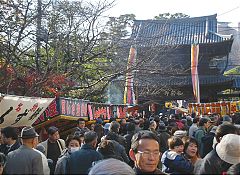 |  |
| Sengakuji on the 300th anniversary of the avenge (December 14, 2002) | |
The temple is a few steps from Sengakuji Station on the Subway Toei Asakusa Line. Alternatively, you can walk there from either Shinagawa or Tamachi Station on the JR Yamanote Line in about 15-20 minutes.
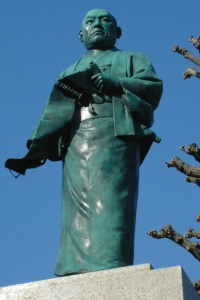
The Story of the 47 RoninIn March 1701, lord Asano Takuminokami of Ako (today's Hyogo Prefecture) attacked lord Kira Hozukenosuke at Edo castle. Asano lost patience after repeatedly being provoked and treated arrogantly by Kira, but failed to kill him in the attack. On the same day, Asano was sentenced to commit seppuku (ritual suicide), while Kira was not punished at all, despite the contemporary custom of punishing both parties in similar incidents. In addition, the whole Asano family was removed from power, leaving Asano's samurai without a job and a strong will to avenge their unfairly punished master. For over one and a half year, the samurai prepared the avenge under difficult circumstances. On December 14, 1702, the remaining group of 47 ronin under their leader Oishi Kuranosuke finally succeeded to avenge their master by killing lord Kita in his mansion. Afterwards, they carried Kira's head to Sengakuji, and were later sentenced to commit seppuku. The story of the 47 ronin became highly popular as a kabuki play during the Edo Period, and remains very popular today in Japan where loyalty, endurance and will power are some of the most respected characteristics. |
Yasukuni Shrine
The Yasukuni Shrine is a Shinto shrine located in Tokyo that commemorates Japan's war dead.
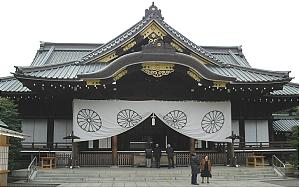
The shrine was founded in 1869 as Tokyo Shokonsha, and was renamed Yasukuni Shrine in 1879. It was build in order to commemorate and worship those who have died in war for their country and sacrificed their lives to help build the fundament for a peaceful Japan (the meaning of Yasukuni is "peaceful country").
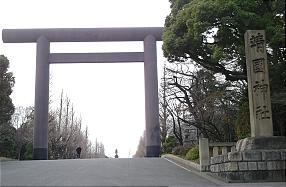
The deities of about 2.5 million people who died for Japan in the conflicts accompanying the Meiji Restoration, the Satsuma Rebellion and similar domestic conflicts, the First Sino-Japanese War, the Russo-Japanese War, the First World War, the Manchurian Incident, the Second Sino-Japanese War and the Pacific War are enshrined at Yasukuni Shrine in form of written records, which note name, origin and date and place of death of everyone enshrined.
The Yushukan, a museum commemorating Japan's wars is located just next to the shrine's main buildings.
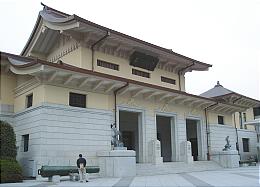
A big political contravercy surrounds the Yasukuni Shrine because since 1978, fourteen class A war criminals are among the 2.5 million people enshrined at Yasukuni. Furthermore, the visits by several Japanese prime ministers to the shrine since 1975 have been causing concerns regarding a violation of the principle of separation of church and state.
For some people, especially in the Asian countries which suffered most under past Japanese imperialism, the shrine has become a symbol for Japanese militarism and ultra-nationalism, and many are taking the prime ministers' visits as a sign hat Japan's political leaders are not looking critically enough at their country's history.
Attempts to remove the war criminals from the Yasukuni Shrine have failed due to the shrine's refusal. Other discussions to solve the problem center around plans to create a currently non-existent alternative to the Yasukuni Shrine for commemorating and worshipping Japan's war dead.
A short walk from Kudanshita Station on the Subway Hanzomon, Tozai and Shinjuku Lines.
Zojoji Temple
Zojoji Temple was built in the year 1393, and was moved to its present location in 1598. It is the main temple of the Buddhist Jodo sect in the Kanto area. Tokyo Tower now stands just next to the temple.
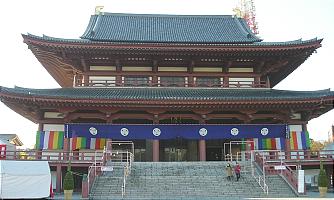
After Tokugawa Ieyasu moved to Edo (former name of Tokyo) in 1590, the Zojoji Temple became the Tokugawa family temple. A mausoleum of the Tokugawa family can be found on the temple grounds, and the crest of the Tokugawa family still decorates the temple buildings.
Zojoji's main gate is the Sangedatsumon. It was constructed in 1605 in a contemporary Chinese Tang Dynasty style.
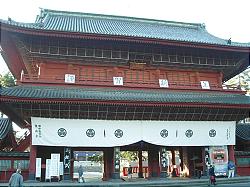 | 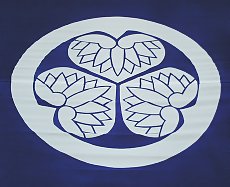 |
The closest subway stations are Onarimon or Shibakoen Station on the Mita Line and Daimon Station on the Oedo Line. Zojoji is also a 5-10 minute walk from Hamamatsucho Station on the JR Yamanote and JR Keihin-Tohoku Line.
Imperial Palace
The current Imperial Palace (Kokyo) is located on the former site of Edo Castle, a large park area surrounded by moats and massive stone walls in the center of Tokyo, a short walk from Tokyo station. It is the residence of Japan's Imperial Family.
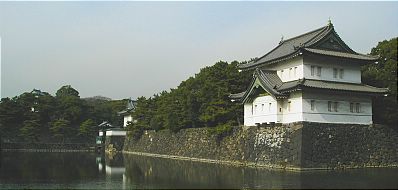
Edo Castle used to be the seat of the Tokugawa shogun who ruled Japan from 1603 until 1867. In 1868, the shogunate was overthrown, and the country's capital and Imperial Residence were moved from Kyoto to Tokyo. In 1888 construction of a new Imperial Palace was completed. The palace was once destroyed during World War Two, and rebuilt in the same style, afterwards.
From Kokyo Gaien, the large plaza in front of the Imperial Palace, visitors can view the Nijubashi, two bridges that form an entrance to the inner palace grounds. The stone bridge in front is called Meganebashi (Eyeglass Bridge) for its looks. The bridge in the back was formerly a wooden bridge with two levels, from which the name Nijubashi (Double Bridge) is derived.
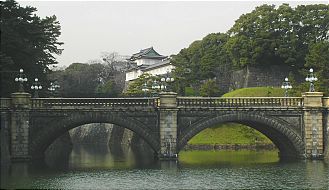
The palace buildings and inner gardens are not open to the public. Only on January 2 (New Year's Greeting) and December 23 (Emperor's Birthday), visitors are able to enter the inner palace grounds and see the members of the Imperial Family, who make several public appearances on a balcony.
During the rest of the year, guided tours of the palace are offered in Japanese, with an English pamphlet and audio guide provided. Tours must be reserved in advance at the Imperial Household Agency. Reservations over the internet are possible.
The Imperial Palace East Gardens are open to the public throughout the year except on Mondays, Fridays and special occasions. Please visit the East Gardens information page for more information.
Imperial Palace is a 5-10 minute walk from Tokyo Station.
Tsukiji Fish Market
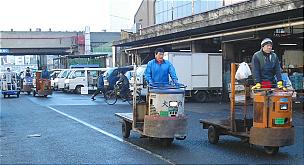
Tsukiji Central Wholesale Market is a large wholesale market for fish, fruit and vegetables in central Tokyo. It is the most famous of over ten wholesale markets that handle the collection and distribution of fruit, vegetables, flowers, meat and fish in metropolitan Tokyo. Tsukiji Market is best known as one of the world's largest fish markets, handling over 2,000 tons of marine products per day.
The sight of the many kinds of fresh fish, shellfish and other seafood and the busy atmosphere of scooters, trucks, sellers and buyers hurrying around, make Tsukiji Market one of Tokyo's major tourist attractions. However, since Tsukiji Market is a site where serious business is conducted, it is important for visitors not to interfere with the action by not bringing any large bags and not obstructing traffic along the narrow lanes.
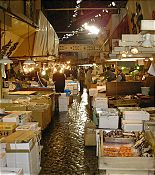 | 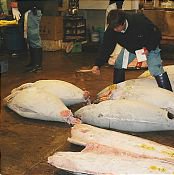 |  |
A visit is most recommended in the early and busy morning hours before 9am. Note however, that the spectacular tuna auctions, held around 5am, have been closed to tourists as of May 2005 due to the interference caused by the sheer number of spectators and cases of misbehaving tourists (visitors touching tuna, obstructing people at work and causing distraction by flash photography).
A visit to Tsukiji Market is best combined with a sushi breakfast at one of the several restaurants which are located in the market. Most of them open around five in the morning and close around noon.
The market is closed on Sundays, holidays and certain other days.
Tsukiji Market is best accessed from Tsukijishijo Station on the Subway Oedo Line or Tsukiji Station on the Subway Hibiya Line.
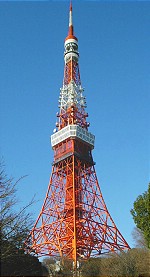
Tokyo Tower
With 333 meters, Tokyo Tower is 13 meters taller than its model, the Eiffel Tower of Paris, and the world's tallest self-supporting steel tower. It was completed in the year 1958 as a symbol for Japan's rebirth as a major economic power, and serves as a television and radio broadcast antenna and tourist attraction.
Visitors can ascend to the main observatory at 150 meters and the special observatory at 250 meters to get a bird's eye view of Tokyo. Under good weather conditions, Mount Fuji can be seen in the distance. A ride to the top floor, the special observatory, costs roughly 1500 Yen per adult.
An aquarium, wax museum and several more attractions can be found on the ground floors of the tower. Separate entrance fees apply.
It is recommended to combine a visit to Tokyo Tower with a visit to Zojoji Temple, one of Tokyo's major temples, that is located just next to the tower.
The closest subway stations are Onarimon Station on the Mita Line and Akabanebashi Station on the Oedo Line. Tokyo Tower is also a 10 minute walk from Hamamatsucho Station on the JR Yamanote and JR Keihin-Tohoku Line.
Ryogoku
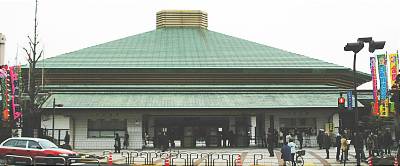
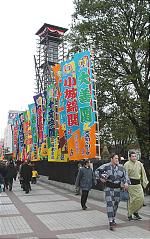
Ryogoku is an area of Tokyo where the sumo stadium, many sumo stables, chanko restaurants and other sumo related sights can be found. It is the center of the sumo world.
Until the beginning of the 20th century, sumo tournaments were held outdoors at shrines and temples. In 1909, the first permanent sumo hall was built in the Ryogoku area, where outdoor sumo events had been held for a long time before.
The current Kokugikan is in the fourth permanent sumo stadium built in Tokyo. It has been in use since 1985, and is located just next to Ryogoku Station. It sits over 10,000 visitors and hosts three of the six annual sumo tournaments (in January, May and September).
Sumo stables are the places where sumo wrestlers live and train. Among the several dozens of sumo stables currently in existence, many are located in the Ryogoku area. At some stables, it is possible to view the sumo practice in the early morning hours.
Chanko nabe is the staple food of sumo wrestlers. It is a hot pot dish that comes in many varieties and contains vegetables, seafood and meat. There are several restaurants in the Ryogoku area that feature chanko nabe on their menus.
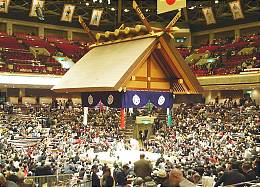 | 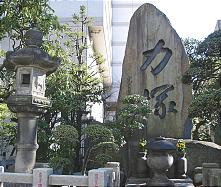 |
Take the JR Sobu Line or Subway Oedo Line to Ryogoku Station.
NHK Studiopark
NHK (Nippon Hoso Kyokai = Japan Broadcasting Group) is Japan's public television and radio broadcaster. Its headquarters are located in Shibuya, Tokyo, next to Yoyogi Park.
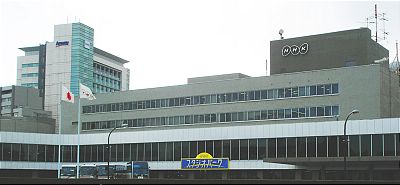
NHK Studiopark is a part of the NHK Broadcasting Center that is open to the public. For a small entrance fee, it gives visitors a chance to look behind the scenes of NHK broadcasting.
At NHK Studiopark, visitors can observe how television programs such as the popular morning drama, the historical Taiga Drama and the kids program "Okaasan to issho" are being recorded, and on weekdays from around 1pm can watch the nationwide live broadcast of the talk program "Stadiopark kara konnichiwa" from behind the scenes.
Furthermore, there are attractions which introduce various broadcasting technologies such as dubbing, computer graphics, digital broadcasting and 3D images, and illustrated information about popular programs of the past, NHK announcers and broadcasting history. Finally, there is a shop where NHK related goods, tapes and books can be purchased.
NHK Studiopark is a 5-10 minute walk from Harajuku Station on the JR Yamanote Line and Meiji-jingu-mae Station on the Subway Chiyoda Line.